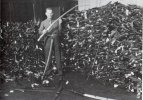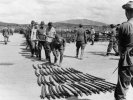t1mpani
Platinum Member
- Joined
- Jun 6, 2002
- Messages
- 5,526
Hello again, generous founts of knowledge. It seems that acquaintances of mine have decided that I'm "THE GUY" to take their inherited swords to in order to get information on them, despite constant protestations on my part that all I've ever done is take pictures of Japanese swords and then shown those to people who actually know what they're talking about--something that they could easily do themselves. Still, the wife of a friend brought this to me, batted her long eyelashes and would-you-pleased me in her best feathery southern belle, so here I am again. I apologize for the lighting--my light box is not big enough for swords, and achieving diffusion continues to be a challenge.
First up, let me calm your concerns--I did not, ever, place bare fingers on the blade or bare tang, I always pick it up with a clean washcloth (having been scolded before for having NOT done so!). I can also take any additional shots or give any additional measurements you might require. The measurements I have taken are an overall length of 38", and blade length of 27 3/8", and a blade thickness which tapers from 7/32" to just under 5/32" before the pronounced taper to the tip. The mekugi appears to be horn, the spring-loaded scabbard retention piece is broken off even with the scabbard (probably somebody trying to un-sheath it who didn't know they had to press the button), and overall I would say the condition of all of the materials seems to be very good, very little shrinking or cracking in the rayskin, very little rattle when assembled, etc. The blade is still EXTREMELY sharp with only a few minor rolled places in the entire length, and doesn't seem to have suffered any well-intentioned touchups. I've tried to take pictures of what I think are key areas, sometimes from a few different angles, just thinking that different lighting may help clear up something for the more trained eyes here.
To me, I suppose, the thing that really sticks out (literally and figuratively) is the signature in the tang, which actually sits proud, reminding me of how many ancient European swords would have lettering chiseled in and then inlays on top. This especially I've tried to hit from a number of angles and play the light on to be as helpful as I can. Perhaps this actually means that it's a machine-made blade and not neat at all, but that's why I'm asking you guys!
Please, at your leisure, help me determine a possible age/idea of this sword for the owner. They're not really interested in selling it, more just knowing if it's something they really ought to make room for in their gun safe, even if it means knocking a rifle out. My thanks as always to you gentlefolk.













And more to come in the next post...
First up, let me calm your concerns--I did not, ever, place bare fingers on the blade or bare tang, I always pick it up with a clean washcloth (having been scolded before for having NOT done so!). I can also take any additional shots or give any additional measurements you might require. The measurements I have taken are an overall length of 38", and blade length of 27 3/8", and a blade thickness which tapers from 7/32" to just under 5/32" before the pronounced taper to the tip. The mekugi appears to be horn, the spring-loaded scabbard retention piece is broken off even with the scabbard (probably somebody trying to un-sheath it who didn't know they had to press the button), and overall I would say the condition of all of the materials seems to be very good, very little shrinking or cracking in the rayskin, very little rattle when assembled, etc. The blade is still EXTREMELY sharp with only a few minor rolled places in the entire length, and doesn't seem to have suffered any well-intentioned touchups. I've tried to take pictures of what I think are key areas, sometimes from a few different angles, just thinking that different lighting may help clear up something for the more trained eyes here.
To me, I suppose, the thing that really sticks out (literally and figuratively) is the signature in the tang, which actually sits proud, reminding me of how many ancient European swords would have lettering chiseled in and then inlays on top. This especially I've tried to hit from a number of angles and play the light on to be as helpful as I can. Perhaps this actually means that it's a machine-made blade and not neat at all, but that's why I'm asking you guys!
Please, at your leisure, help me determine a possible age/idea of this sword for the owner. They're not really interested in selling it, more just knowing if it's something they really ought to make room for in their gun safe, even if it means knocking a rifle out. My thanks as always to you gentlefolk.













And more to come in the next post...













